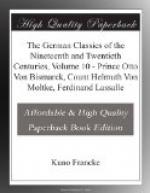The comforts of the Turkish baths I have described to you in an earlier letter. The baths of Brussa are distinguished, because they are not artificially but naturally heated, and so much so that you would not think it possible, at first, to enter the great basin of clear water without being parboiled before you could leave it again. From the terrace of our bath we had a beautiful view, and it was so comfortable there that we hated to leave.
On the thirteenth we rode to Kemlik, at the end of the Bay of Mudania, where there is a dockyard. This is the most beautiful spot I have seen. The clear surface of the sea is lost here between the high and steep mountains, which leave just enough space for the little town and the olive woods. Twilight is very brief in this country, and night had come when we reached the town gate, but what a night! Although the moon happened to be new, objects were distinguishable at a considerable distance, while the evening star shines here so brightly that shadows are cast by its light.
At three o’clock in the morning we were again in the saddle, riding toward the East through a valley and between high mountains, along the same road which Walther von Habenichts once followed with his twelve thousand crusaders. The hills were covered with olive trees and flowering bushes filled with nightingales. At sunset we reached the extensive lake of Isnik. The gigantic walls and towers on the opposite shore used to protect a powerful city, for which the crusaders often fought. Today they surround the few miserable huts and rubbish heaps which centuries ago were Nicea. It was here that an assembly of one hundred learned bishops expounded the mystery of the Trinity, and decided to burn all who held a different view. What would these proud prelates have said if a man had prophesied to them that the time would come when their rich and mighty city would be a rubbish heap, and their cathedral the ruins of a Turkish mosque; when the empire of the Greek emperors would be destroyed, and their own exegesis, yes, even their entire religion, would have disappeared from these parts, and when for hundreds of miles and through hundreds of years the name of the camel-driver of Medina would be the only one in the mouths of the people.
The Moslems, who abhor all pictures, have covered with whitewash the paintings in the Greek churches. In the Cathedral of Nicea, where the famous council was held, there glistens even today through the white coating of the wall, where the high altar used to be, the proud promise, I.H.S. (in hoc signo, i. e., under this sign, the cross, you will win). But directly over it is written the first dogma of Islam, “There is no God but God.” There is a lesson of tolerance in these faded inscriptions, and it seems as if Heaven itself wished to listen as well to the Credo as to the Allah il allah. One of the chief pursuits of the honest Turks is what they call Kief etmek, literally “creating




